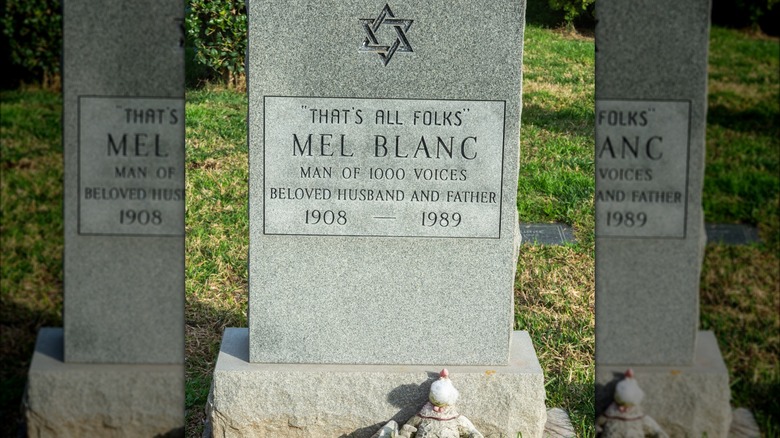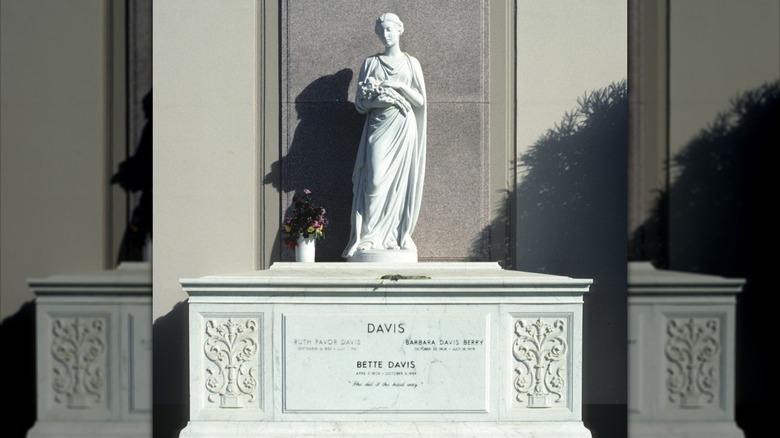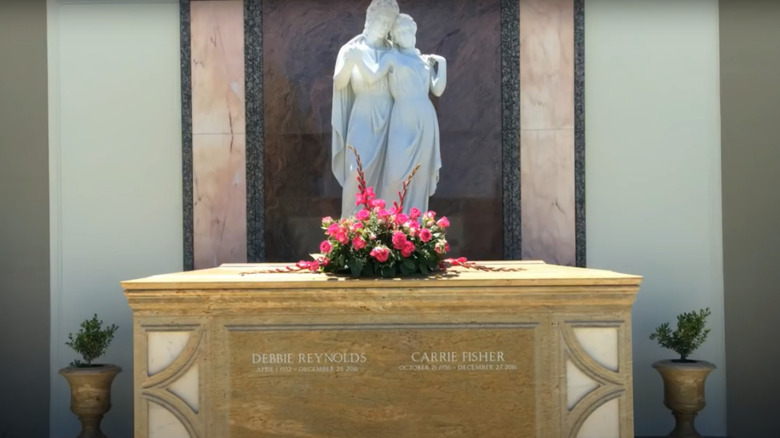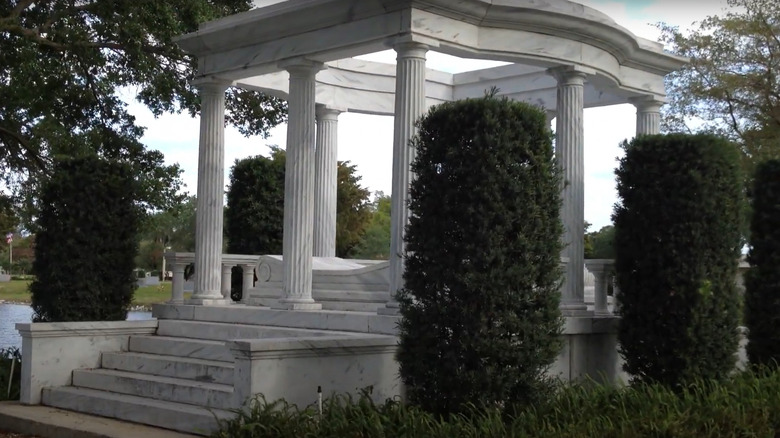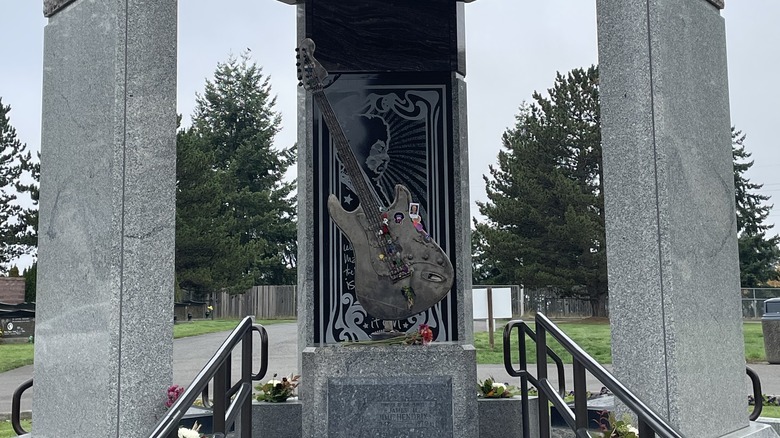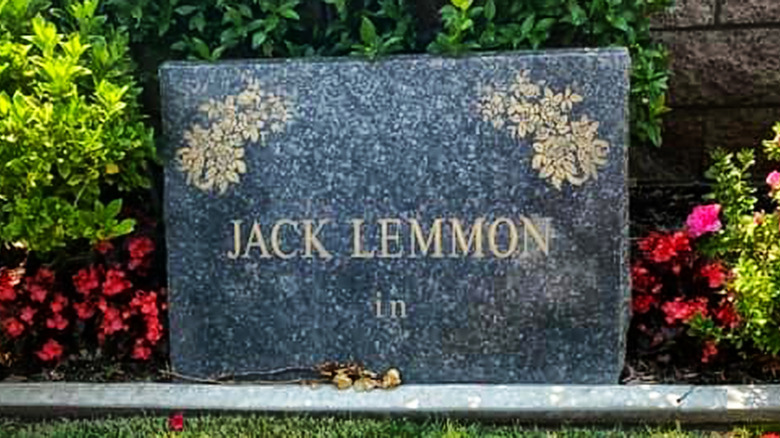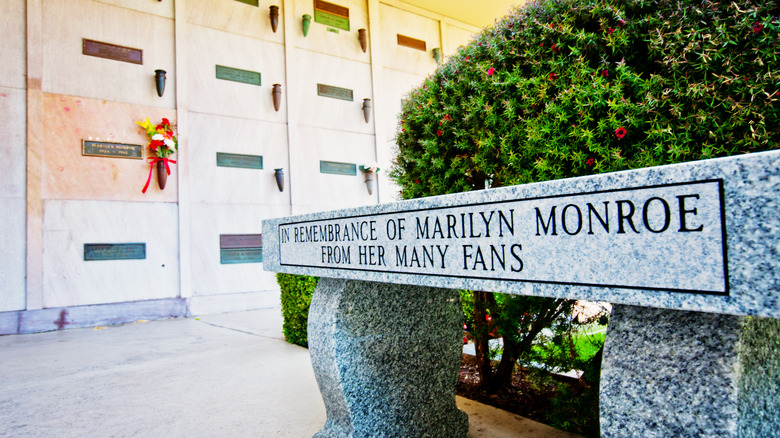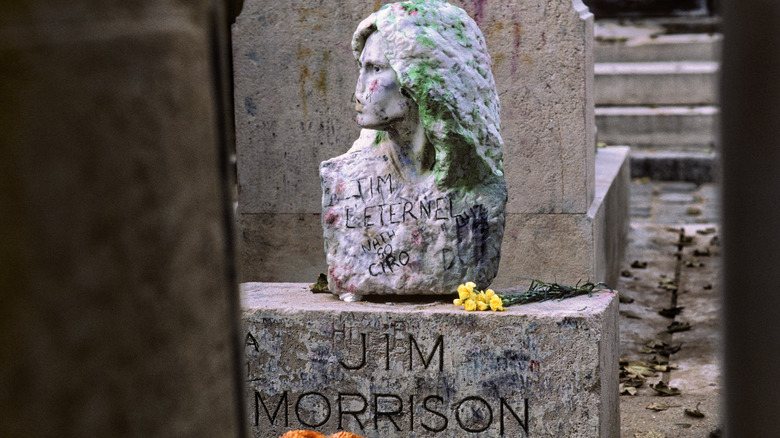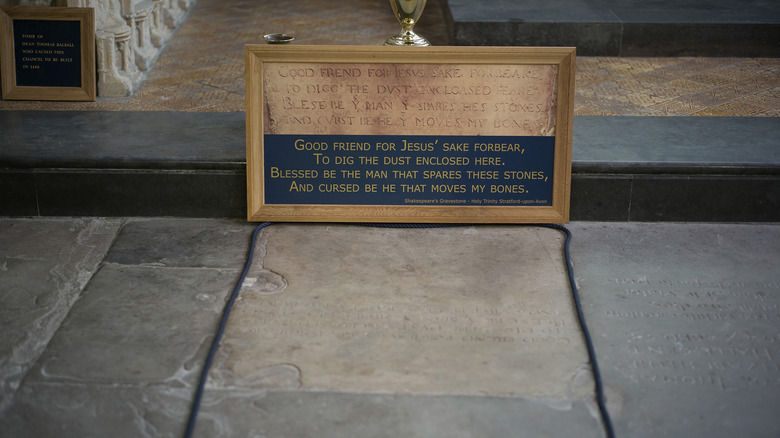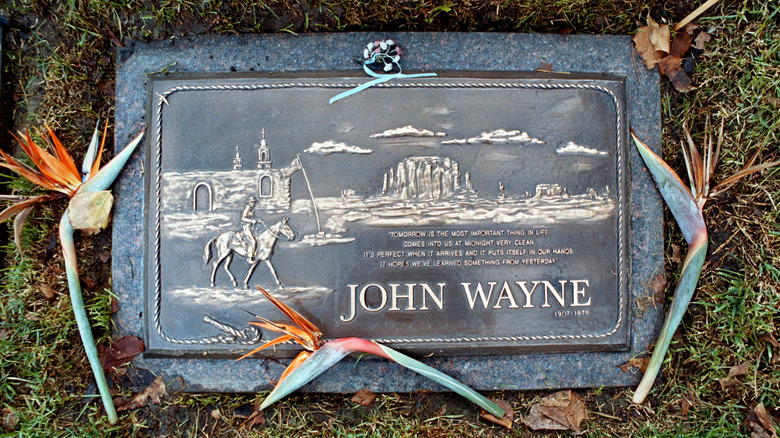10 Celebrity Graves That Will Take Your Breath Away - For Better Or Worse
A celebrity's grave site serves a complicated purpose. On the one hand, it gives a final resting place to a human being, where they can be remembered and visited by family, friends, and colleagues – some actors are never the same after the death of a co-star. On the other hand, it can also be a place for these public figures to be mourned by legions of fans who, despite never knowing them personally, may feel as though they did through a profound connection to their work.
Because of this, many of these memorials strike a delicate balance between respectful reverence and maintaining the spectacle of celebrity long after the person has passed on. From simple headstones and plaques to large structures meant for gathering, these graves — which are all works of art in their own right — beautifully evoke the spirit, legacy, and talent of the artists they represent.
Mel Blanc's epitaph is a poignant tribute
Some epitaphs are so distinct, so perfectly chosen to represent the life and personality of a loved one, that you can practically hear their voice when you read it across their gravestone. This sentiment is no truer for any late celebrity than it is for actor Mel Blanc. Throughout the 20th century, he lent his voice talents — unmatched in both variety and impact — to numerous characters in the "Looney Tunes" universe, including Bugs Bunny, Daffy Duck, and Porky Pig (as well as many more you likely never realized he voiced). He continued voicing these characters until his death in 1989 due to complications from heart disease.
Blanc was laid to rest in the Hollywood Forever Cemetery in Los Angeles, California, where fans of his work can visit from all over the world to pay respects to one of the greatest voice actors of all time. Compared to some other celebrity gravestones, it's rather modest in design — fittingly, it's the evocation of Blanc's vocal talent that makes it so memorable. Beneath a Star of David (a symbol of Blanc's Jewish heritage), the grave quotes "That's all folks," the iconic sign-off of his character Porky Pig. Further down, it proclaims him as the "man of 1,000 voices," as well as a "beloved husband and father." The grave has been photographed many times with small stuffed animals of Blanc's characters laid nearby, presumably by those whose childhoods he filled with laughter.
Bette Davis did it the hard way
Two-time Academy Award-winning actor Bette Davis left a legacy as one of the most prolific and decorated performers of the 20th century. Her career spanned six decades, with "Dark Victory," "Whatever Happened to Baby Jane?," "All About Eve, and "Death on the Nile" just a few of her notable credits. She died in France in 1989 at the age of 81, having been diagnosed with breast cancer five years earlier. She was laid to rest soon after in Forest Lawn Memorial Park in the Hollywood Hills.
She shares an altar-style crypt with her mother Ruth Favor Davis and her sister Barbara Davis Berry, who passed away in 1961 and 1979, respectively. Atop the altar is a small statue of a woman holding flowers. Below Bette's name are the words "She did it the hard way," which she once said she wanted on her grave. This is a reference to how hard Bette Davis had to fight to make it in Hollywood — she famously locked horns with execs at Warner Bros. and came out on top, getting the roles that her talent deserved. "Warners was a tough guy's studio, and it took a tough woman to stand up to the boys in the front office," Time magazine said following her death.
Carrie Fisher and Debbie Reynolds share a resting place
Fans were shocked and saddened when Carrie Fisher, who was best known for playing Princess Leia Organa in the "Star Wars" franchise, unexpectedly passed away on December 27, 2016 at the age of 60. Fisher had been featured through CGI in "Rogue One: A Star Wars Story" just a few weeks earlier, and she was slated to appear in mainline "Star Wars" sequels (unused footage from 2015's "Star Wars: The Force Awakens" was ultimately repurposed for 2019's "Star Wars: The Rise of Skywalker"). But before anyone could even begin to process the tremendous loss experienced by the entertainment world, another great loss occurred — Fisher's mother, Debbie Reynolds.
Reynolds, a Golden Age Hollywood legend, died from a stroke aged 84 less than 24 hours after her daughter passed. They share an altar in Hollywood's Forest Lawn Memorial Park. It bears no epitaph, though it does feature a touching statue of two women — a mother and a daughter — dancing together in an embrace. When the grave and statue were first erected without names, onlookers speculated based on the piece that it was to serve as their joint resting place, and they were correct. Fisher was cremated, but a portion of her ashes were placed in a coffin to be buried with Reynolds.
Jackie Gleason has a very impressive tomb
Comedian and actor Jackie Gleason, who appeared in some of the most classic comedic films ever made, devoted his life to making people laugh. The Brooklyn native was best known for producing a number of variety shows including "The Jackie Gleason Show" and the sketch series "The Honeymooners," though he was also well known for his turn as Minnesota Fats in "The Hustler" (for which he was nominated for an Oscar in the best supporting actor category) and Sheriff Buford T. Justice in "Smokey and the Bandit."
Gleason died from cancer on June 24, 1987 at the age of 71 in Florida, where he is said to have moved in 1964. His final resting place is a large outdoor tomb in Doral, Florida, at Our Lady of Mercy Catholic Cemetery. Erected next to a lake in an open field surrounded by a few trees, Gleason's tomb really is quite something. His sarcophagus sits in the center of a circle of ornate columns with steps leading up it. His epitaph reads "And away we go," a reference to his 1954 album of the same name.
Jimi Hendrix's grave is a monument to his music
Considered one of the greatest musicians to have ever walked the earth, Jimi Hendrix's death in 1970 at the age of 27 is arguably one of the darkest moments in popular music history. There's a long list of actors who have died at 27, and plenty of musical artists have passed away at that young age too, such as Amy Winehouse and Kurt Cobain. Collectively, Hendrix and others who have died at this age are sometimes referred to as the 27 club. The causes of death are of course widely varied — Hendrix "died of asphyxia while intoxicated with barbiturates," a police report confirmed.
He was in London when he passed, but body was flown back to the U.S. shortly afterward and he was soon buried at Greenwood Cemetery in Renton, Washington. Originally, the family was only able to afford a simple grave marker, which fans from around the world still came to visit in large droves. When Hendrix's father Al was able to win back the rights to his son's music, he was also able to afford a dramatic expansion to the memorial site that would both better reflect his status in the music world and provide a more suitable, sizable venue for fans to congregate in reverence.
The final site is perhaps one of the largest and most complex of its kind. It's an impressive marble structure that resembles a gazebo, with several public entryways and a domed roof. The interior walls feature portraits of the artist with accompanying lyrics from songs like "The Story of Life" and "Message to Love." The stunning centerpiece is a sculpted replica of his guitar, representing his place as one of the world's greatest guitarists.
Jack Lemmon's grave is simplicity at its finest
With a career spanning five decades, there's little doubt that Jack Lemmon was one of the greatest American actors to ever grace the stage or screen. His work helped define what audiences came to expect of a prototypical leading man throughout the 20th century, having starred in the likes of "Some Like It Hot," "The Apartment," "Days of Wine and Roses," "The China Syndrome," and "Save the Tiger," (the last of which earned him an Academy Award for best actor). Lemmon died in 2001 at the age of 76, with his publicist Warren Cowan confirming the cause to be complications from cancer.
Lemmon's funeral appears to have been a small, private affair, which was attended by some of the most prominent actors to have ever worked in the film industry. This included Kirk Douglas, Michael Douglas, Catherine Zeta Jones, Shirley Maclaine, and Sidney Poitier. He was buried at California's Pierce Brothers Westwood Village Memorial Park and Cemetery in close proximity to some other Hollywood legends. Though his grave — a simple yet elegant bevel marker — isn't as flashy as other entries on this list, it has one of the most ingenious inscriptions in the history of celebrity graves. It bears no epitaph and lacks both a date of birth and date of death. Instead, underneath gold laurels, it reads "Jack Lemmon in" — a truly legendary final title card for an actor more than worthy of it.
Fans often leave kiss marks on Marilyn Monroe's crypt
The life of Hollywood icon Marilyn Monroe has been the subject of much fascination, interpretation, and even speculation, with films like "Blonde" adapting her true story and getting plenty of the details wrong. One thing that most historians agree on is that the final months of her life were dark, with Monroe gradually withdrawing from public life: In its report on her death, Variety said that she "often tried without success to shut herself off from the world."
The star of hits like "Gentlemen Prefer Blondes" and "Some Like It Hot" died on August 4, 1962 of what authorities eventually learned was a drug overdose. Though there was no way to be absolutely certain, they deemed it probable that this was a case of death by suicide. However, Monroe's half-sister Berniece Baker Miracle isn't entirely convinced, as she says they spoke shortly before her death and discussed Monroe's plans for the future.
Monroe was entombed in a marble wall crypt at Westwood Memorial Park following an open-casket funeral attended only by a handful of those closest to her. Joe DiMaggio, who was briefly married to Monroe, placed three red roses in her hands during the touching ceremony. The baseball legend reportedly had red roses placed near Monroe's crypt twice weekly for the next 20 years. Admirers of Monroe continue to visit the site to express their affection for her, leaving noticeable kiss-marks on her marker with red lipstick.
Jim Morrison has one of the most visited graves in the world
Quintessential rock frontman Jim Morrison changed the music world forever as the face of the Los Angeles band The Doors, bringing counter culture edge to the forefront of the genre. He died suddenly on July 3, 1971 while visiting Paris, France. Speculation about his cause of death has persisted in the decades since, as French authorities declined to perform an autopsy (the cause of death was recorded as heart failure). It has been theorized it may have been the cause of an accidental overdose. He was 27, and is remembered as one of the most prominent "members" of the tragic 27 club.
Having died in Paris as an important member of the artistic community, Morrison was eligible to be buried in the famous Père Lachaise Cemetery with the likes of Oscar Wilde, Frédéric Chopin, and Molière. His grave was unmarked at first, though fans were able to find it nonetheless via the funeral directory. Morrison's site drew heavy traffic from passionate admirers, who also began to leave tokens — and deface the site with graffiti.
A sculptor eventually got permission to place a more formal grave on the plot — a large marble altar with only Morrison's name engraved on the side and a bust of him on top. This too was defaced, and the sculpted bust was eventually stolen by an unknown thief. Finally, his father George replaced the slab altar with a simpler marker bearing more traditional engravings, as well as the epitaph "ΚΑΤΑ ΤΟΝ ΔΑΙΜΟΝΑ ΕΑΥΤΟΥ." The Greek phrase is often translated to mean "True/faithful to his spirit" or "True/faithful to his demon."
William Shakespeare cursed his own grave
To this day, there is no official record of how William Shakespeare died. The English playwright is one of, if not the most famous writer of all time, having penned plays that are still performed and adapted today and laid the groundwork for centuries of dramatic storytelling. We do know he died on April 23, 1616 at the age of 52, and was thereafter buried in the Holy Trinity Church in his hometown of Stratford-upon-Avon. His wife and son-in-law are buried next to him. The graves themselves aren't terribly striking, though Shakespeare's contains an ominous stanza that seems to curse anyone that would dare rob his grave or attempt to move his remains. The epitaph reads, "Good friend for Jesus' sake forbear / To dig the dust enclosed here / Blessed be the man that spares these stones / And cursed be he that moves my bones."
In 2008, a group of historical architects and preservationists were hired to perform minor restorations to the grave, and specifically told reporters that they would not disturb the bones. "Over the years [the stones atop the grave have] started to laminate," a representative for the group told the BBC, adding that "the surfaces are coming off, and with people walking over them... the surfaces are getting eroded." Little did they know that something was missing. Scientists observing Shakespeare's remains with radar technology in 2016 discovered that someone had apparently risked Shakespeare's curse — his skull had seemingly been stolen at some point, perhaps centuries ago. "It's very, very convincing to me that his skull isn't at Holy Trinity at all," archaeologist Kevin Colls of Staffordshire University told the BBC.
John Wayne leaves one last Western portrait
The actor most synonymous with the Western genre that carried Hollywood for so long, John Wayne is a man who needs no introduction. He died on June 11, 1979 due to complications from stomach cancer. Though his illness was largely attributed to years of heavy tobacco smoking, some — including his own children — have raised questions as to whether or not one of his last films played a role in his demise. For the 1956 movie "The Conqueror," Wayne and the crew shot several scenes downwind of a U.S. Government nuclear testing site. 41% of the cast and crew developed some form of cancer during their lifetime, though correlation between this fact and the movie's shooting location have been disputed.
Following his death, Wayne's children buried his remains at Pacific View Memorial Park. They went against his requests to have the epitaph "Feo, Fuerte y Formal" (Ugly, Strong and Dignified), instead leaving the grave unmarked so as not to encourage visitors, both to preserve their father's peace and prevent his many fans from disturbing the graves of those he shared the park with. However, in 1998, the family decided to give him a proper grass marker, still modest but more befitting Wayne's legacy.
The bronze plaque features a Western landscape, with a man riding on horseback through a plain with a few clouds in the sky. It also bears a longer epitaph, which reads, "Tomorrow is the most important thing in life. Comes into us at midnight very clean. It's perfect when it arrives and it puts itself in our hands. It hopes we've learned something from yesterday." It appears to have been taken from a 1971 interview Wayne gave to Playboy.
If you or anyone you know needs help with addiction issues, help is available. Visit the Substance Abuse and Mental Health Services Administration website or contact SAMHSA's National Helpline at 1-800-662-HELP (4357).
If you or someone you know needs help with mental health, please contact the Crisis Text Line by texting HOME to 741741, call the National Alliance on Mental Illness helpline at 1-800-950-NAMI (6264), or visit the National Institute of Mental Health website.
If you or someone you know is struggling or in crisis, help is available. Call or text 988 or chat 988lifeline.org

